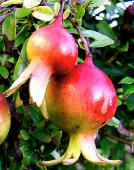Punica Granatum Pomegranate Is Just One Name for This Amazing Food

Punica granatum pomegranate fruit represents fertility and romance. It is mentioned in the Bible several times. The pomegranate has been mentioned in writings across the world.
What is the origin of this ancient fruit?
About Punica granatum pomegranate…
It belongs to the family called Punicaceae. There are two species included in this family. One is Punica granatum and the other is P. protopunica Balf. The second species is not found anywhere in the world except on an island located in the Indian Ocean called Socotra.
A Pomegranate By Any Other Name…
Pomegranates have many other names by which it is known. This shouldn’t come as a surprise given that these bushes and trees are grown all over the world. It would make sense that it would be called many different things by different peoples. Here are some of the other names by which Punica granatum pomegranate is known.
- Spanish – granada (fruit), granado (plant)
- Persia – dulim or dulima
- Sanskrit – dalim or dadima
- Germany – granatapfel
- Dutch – granaatappel
- Malaya – delima
- Italy – melogranato, pomo granato, pomo punico, or melograno granato
- Thailand – tab tim
- Indonesia – gangsalan
- Brazil – romeira, romazeira, or roma
- Guatemala – granad
- Samoan name – limoni
In the United States, it is often misspelled as “pomegranite”.Historical Accounts, Legends, or Writings About PomegranatesThere are many mentions of pomegranates in ancient writings from across the world. Here we’ve listed a few of the references in which you may be interested.
- Christians see pomegranates as one of the symbols of Jesus’ resurrection.
- It’s also associated with a Roman goddess called Persephone. According to legend, she was forced by Pluto to reside in the underworld for a certain number of months of the year and while she was there, she was only allowed to eat the seed of the pomegranate (mentioned in a Homeric Hymn).
- Jewish traditions point to the pomegranate fruit as a symbol of righteousness. At the time this was practiced, it was thought that every fruit had 613 seeds. This number is also associated with the number of commandments recorded in the Torah.
- Pomegranates are mentioned in Scripture too.
- Deuteronomy 8:8
- Exodus 28:33 – the garment of the high priest had pomegranates woven from yarn around the hem of the robe
- 1 Kings 7:42 – four hundred pomegranates decorated the temple pillars
- 2 Chronicles 4:13 – the same passage as the one in 1 Kings
- Song of Songs 4:3 and 6:7 – likened to the temples of his beloved (the red interior of the fruit)
- Jeremiah 52:22-23 – Solomon’s temple was adorned with stone pomegranates
It is said that Punica granatum pomegranate has also been used as a symbol of chastity and unity. The rind of the fruit has been used in ancient days to dye clothing. The seeds and the juice of the seeds have been used for medicinal purposes for hundreds of years.
Quite an amazing fruit, isn’t it?
Read enough about punica granatum pomegranate and want to discover more about the pomegranate tree?
Amazing Pomegranate Health Benefits







